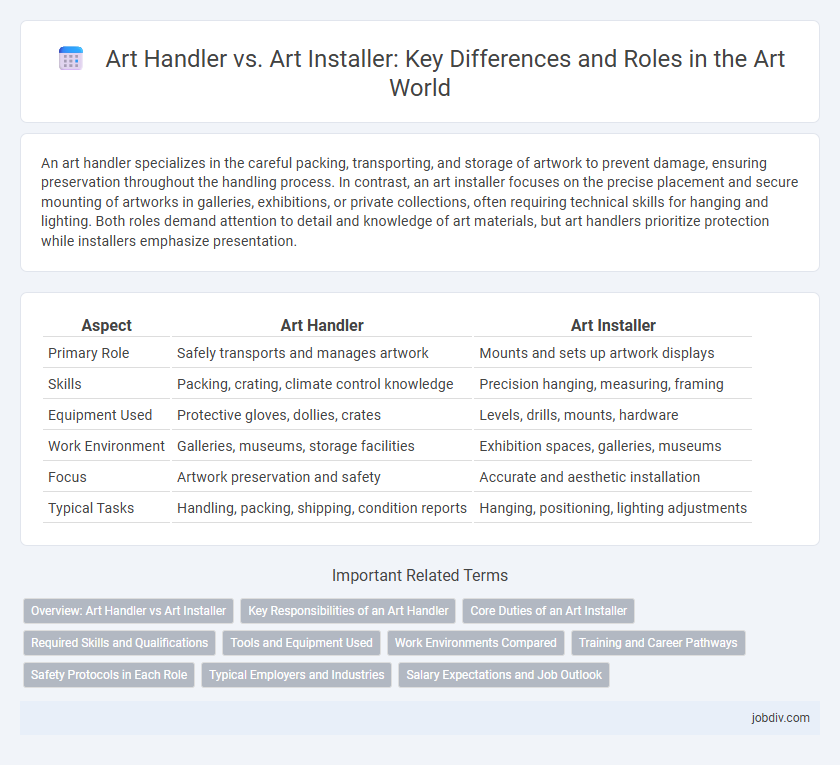An art handler specializes in the careful packing, transporting, and storage of artwork to prevent damage, ensuring preservation throughout the handling process. In contrast, an art installer focuses on the precise placement and secure mounting of artworks in galleries, exhibitions, or private collections, often requiring technical skills for hanging and lighting. Both roles demand attention to detail and knowledge of art materials, but art handlers prioritize protection while installers emphasize presentation.
Table of Comparison
| Aspect | Art Handler | Art Installer |
|---|---|---|
| Primary Role | Safely transports and manages artwork | Mounts and sets up artwork displays |
| Skills | Packing, crating, climate control knowledge | Precision hanging, measuring, framing |
| Equipment Used | Protective gloves, dollies, crates | Levels, drills, mounts, hardware |
| Work Environment | Galleries, museums, storage facilities | Exhibition spaces, galleries, museums |
| Focus | Artwork preservation and safety | Accurate and aesthetic installation |
| Typical Tasks | Handling, packing, shipping, condition reports | Hanging, positioning, lighting adjustments |
Overview: Art Handler vs Art Installer
Art handlers specialize in the careful packing, transporting, and storage of artwork to prevent damage, ensuring preservation during handling and transit. Art installers focus on the precise placement, mounting, and securing of artwork in galleries, museums, or exhibitions, emphasizing aesthetic presentation and structural safety. Both roles require expertise in art care, but handlers prioritize protection and logistics, while installers prioritize display and spatial arrangement.
Key Responsibilities of an Art Handler
Art handlers specialize in the safe packing, transportation, and storage of artwork, ensuring pieces are protected from damage and environmental factors throughout transit. They meticulously prepare materials, apply protective coverings, and use specialized tools and equipment to move delicate and valuable objects within galleries, museums, or during shipping. Their role also includes condition reporting and maintaining documentation to guarantee the integrity and provenance of each artwork during handling processes.
Core Duties of an Art Installer
Art installers specialize in the physical setup and placement of artworks in galleries, museums, and private collections, ensuring the pieces are securely mounted and displayed according to specific curatorial guidelines. Their core duties include handling delicate artworks with care, using specialized tools and materials for installation, and collaborating closely with curators and art handlers to maintain the integrity and presentation quality of each piece. Precision in measurement, knowledge of art conservation techniques, and adherence to safety protocols are essential skills for an art installer to preserve the artwork's condition during installation.
Required Skills and Qualifications
Art handlers require expertise in safely packing, transporting, and storing artworks, emphasizing knowledge of materials science and conservation techniques to prevent damage. Art installers must possess strong technical skills in mounting, framing, and lighting artworks, along with proficiency in tool handling and spatial design to ensure optimal display conditions. Both roles demand attention to detail, physical stamina, and familiarity with art handling safety standards, but installers often need certifications in equipment operation and construction basics.
Tools and Equipment Used
Art handlers primarily use tools like moving blankets, dollies, and packing materials to ensure safe transportation and storage of artwork, emphasizing protection and careful handling techniques. Art installers rely on specialized equipment such as free-standing scaffolding, laser levels, and precision mounting hardware to accurately display artwork in galleries or exhibitions. Both roles require knowledge of handling fragile materials, but installers focus more on alignment and secure attachment, while handlers prioritize safe movement and packaging.
Work Environments Compared
Art handlers primarily work in museums, galleries, and art storage facilities where they manage the transportation, packaging, and condition reporting of artworks. Art installers operate mainly on-site at exhibition venues or private collections, specializing in the precise placement, mounting, and setup of artworks for display. While art handlers emphasize careful logistics and preservation in controlled environments, art installers focus on aesthetic presentation and technical installation in varied settings.
Training and Career Pathways
Art handlers typically undergo specialized training in handling, packing, and transporting artwork to ensure preservation and damage prevention, often starting through apprenticeships or certificate programs. Art installers focus on the precise placement and installation of artworks in galleries and museums, requiring technical skills in mounting, lighting, and spatial design, with training frequently obtained through vocational courses or on-the-job experience. Career pathways for both roles can evolve into curatorial or conservation positions, with advancements dependent on expertise in art handling protocols, installation techniques, and industry knowledge.
Safety Protocols in Each Role
Art handlers prioritize safety protocols by meticulously packing, cushioning, and securing artworks to prevent damage during transit and storage, utilizing specialized equipment like gloves, lifting tools, and climate-controlled packaging. Art installers focus on precise installation safety measures, including proper handling techniques, secure mounting methods, use of scaffolding or ladders, and adherence to weight limits and wall integrity to ensure artworks are safely displayed without risk of falling or damage. Both roles require comprehensive training in handling techniques and workplace safety standards to protect priceless art and safeguard personnel.
Typical Employers and Industries
Art handlers typically find employment with museums, galleries, auction houses, and art shipping companies where careful packing, transportation, and storage of artworks are critical. Art installers often work for museums, galleries, art fairs, and exhibition companies, specializing in the precise placement, mounting, and display of artworks in various settings. Both roles are essential in the fine arts industry, art logistics, and cultural institutions ensuring the safe handling and proper presentation of valuable art pieces.
Salary Expectations and Job Outlook
Art handlers typically earn an average salary ranging from $30,000 to $45,000 annually, with job opportunities centered around museums, galleries, and shipping companies. Art installers, who specialize in the precise placement and mounting of artworks, command higher salaries, often between $40,000 and $60,000, driven by their technical skills and demand in high-profile exhibitions. The job outlook for both roles is stable, with growth fueled by the expanding art market and cultural institutions investing in professional installation and transport services.
Art Handler vs Art Installer Infographic

 jobdiv.com
jobdiv.com